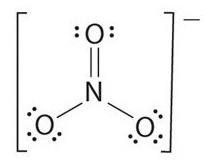
Find the bond order of ${\text{N }} - {\text{ O}}$ bond in ${\text{N}}{{\text{O}}_3}^ - $ .
A. $1$
B. $2$
C. $3$
D. $1.33$
Answer
576.9k+ views
Hint:
We can find the bond order by drawing the lewis structure or lewis dot structure. This structure gives us the information of the bonds between the atoms and lone pairs of electrons present on the atoms. The bond order by lewis structure can be given by $\dfrac{{{\text{Total number of bonds}}}}{{{\text{Number of the bond groups}}}}$ . You can refer to the figure for the lewis structure of ${\text{N}}{{\text{O}}_3}^ - $ .
Complete step by step answer:
Let us first discuss bond order.
Bond order is basically the number of chemical bonds between two atoms of a compound or molecule. According to molecular orbital theory, bond order can also be defined as the difference between the bonds and the anti-bonds. Bonds are formed due to sharing of electrons in bonding orbitals and anti-bonds are formed due to sharing of electrons in antibonding orbitals.
We can find the bond order by drawing the lewis structure or lewis dot structure. This structure gives us the information of the bonds between the atoms and lone pairs of electrons present on the atoms.
Lewis structure of ${\text{N}}{{\text{O}}_3}^ - $ is given in the figure.

As clear from the figure that the total number of ${\text{N }} - {\text{ O}}$ bonds is $4$ and there are $3$ bond groups between the individual atoms.
We know that the bond order by lewis structure can be given by $\dfrac{{{\text{Total number of bonds}}}}{{{\text{Number of the bond groups}}}}$ .
Therefore, bond order of ${\text{N }} - {\text{ O}}$ bond in ${\text{N}}{{\text{O}}_3}^ - $ is $\dfrac{4}{3} = 1.33$ .
Hence the correct option is D.
Note:
Although lewis dot structures can be used to identify the bond orders and bond lengths in a compound, it has certain limitations. It is not able to describe the actual shape of a compound such as for resonance structures. It is primarily based on the concept of octet rule which has further limitations as in electron deficient compounds and odd electrons species.
We can find the bond order by drawing the lewis structure or lewis dot structure. This structure gives us the information of the bonds between the atoms and lone pairs of electrons present on the atoms. The bond order by lewis structure can be given by $\dfrac{{{\text{Total number of bonds}}}}{{{\text{Number of the bond groups}}}}$ . You can refer to the figure for the lewis structure of ${\text{N}}{{\text{O}}_3}^ - $ .
Complete step by step answer:
Let us first discuss bond order.
Bond order is basically the number of chemical bonds between two atoms of a compound or molecule. According to molecular orbital theory, bond order can also be defined as the difference between the bonds and the anti-bonds. Bonds are formed due to sharing of electrons in bonding orbitals and anti-bonds are formed due to sharing of electrons in antibonding orbitals.
We can find the bond order by drawing the lewis structure or lewis dot structure. This structure gives us the information of the bonds between the atoms and lone pairs of electrons present on the atoms.
Lewis structure of ${\text{N}}{{\text{O}}_3}^ - $ is given in the figure.

As clear from the figure that the total number of ${\text{N }} - {\text{ O}}$ bonds is $4$ and there are $3$ bond groups between the individual atoms.
We know that the bond order by lewis structure can be given by $\dfrac{{{\text{Total number of bonds}}}}{{{\text{Number of the bond groups}}}}$ .
Therefore, bond order of ${\text{N }} - {\text{ O}}$ bond in ${\text{N}}{{\text{O}}_3}^ - $ is $\dfrac{4}{3} = 1.33$ .
Hence the correct option is D.
Note:
Although lewis dot structures can be used to identify the bond orders and bond lengths in a compound, it has certain limitations. It is not able to describe the actual shape of a compound such as for resonance structures. It is primarily based on the concept of octet rule which has further limitations as in electron deficient compounds and odd electrons species.
Recently Updated Pages
The number of solutions in x in 02pi for which sqrt class 12 maths CBSE

Write any two methods of preparation of phenol Give class 12 chemistry CBSE

Differentiate between action potential and resting class 12 biology CBSE

Two plane mirrors arranged at right angles to each class 12 physics CBSE

Which of the following molecules is are chiral A I class 12 chemistry CBSE

Name different types of neurons and give one function class 12 biology CBSE

Trending doubts
Which are the Top 10 Largest Countries of the World?

What are the major means of transport Explain each class 12 social science CBSE

Draw a labelled sketch of the human eye class 12 physics CBSE

Differentiate between insitu conservation and exsitu class 12 biology CBSE

The computer jargonwwww stands for Aworld wide web class 12 physics CBSE

State the principle of an ac generator and explain class 12 physics CBSE




